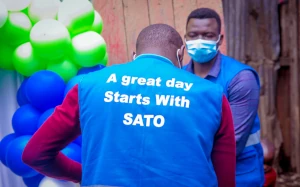
Daigo Ishiyama tells us how he took the SATO Tap from a gleam of an idea to award-winning design in just six weeks.
Just like Archimedes my eureka moment came in the bath.
SATO had already begun planning for a handwashing product as part of its focus on improving lives through sanitation and hygiene solutions, but the arrival of the coronavirus pandemic accelerated the timeline.
The importance of washing hands for the global community was clear for all to see and I was particularly conscious of it after I contracted COVID-19 in Spring 2020 and was isolating at home.
Handwashing with soap is one of the easiest, most affordable ways to limit the spread of respiratory and diarrheal disease and contamination but 40% of the world, 3 billion people, have no easy access to basic handwashing facilities and soap.
I knew we needed something that would be straightforward for anyone, including young children, to use while providing easy access to handwashing wherever it was needed and which did not rely on plumbing or access to running water.
One evening, during my isolation, I was watching my son playing in the bath with his toys when the inspiration for a tap solution came to me.
Within a few weeks I had refined the idea via five prototype models made in my garage. So the initial development was all done at home in six weeks and then just as quickly we got manufacturers on board to provide product we could test thoroughly.
The SATO Tap has a plastic base with a nozzle/connector designed to hold most ordinary plastic drinks bottle with a cap diameter of approximately 30 millimetres. The base enables users to tip the nozzle down to release a steady flow of water – as little as 100ml of water – just enough to wash your hands and 90% less than water consumed by traditional taps, saving the rest of the water in the bottle.
The design relies on pressure and gravity to create a simple on-and-off mechanism. The mechanism can be operated by the use of forearms or elbows which helps to reduce contamination of hands from the previous user or re-contamination of your own hands. Crucially the design, which includes a soap dish, is simple and very cost effective, which is key for accessibility so everyone, everywhere, can benefit from handwashing.
To ensure its reliability we undertook 3.65m testing cycles – equivalent to 100 years of use for a family of five people. Then we took units to test in the real world, and in partnership with UNICEF (a SATO partner) and mWater, performed a trial of the SATO Tap in five countries (Kenya, Tanzania, Ethiopia, Bangladesh and India) to collect feedback from potential users of the product and retailers familiar with consumer preferences. The trial results were overwhelmingly positive.
Participants were able to choose the placement of the Tap in their domestic situation and report on how useful it was. For example in Bihar, India, half of the households placed the Tap outside the house near the well or piped water. Respondents felt that being close to a water source made filling the bottle easier. Other families placed it outside on the veranda to enable handwashing upon entry into the house and a few families placed it inside the house to prevent theft.
We were able to gather lots of vital anecdotal data from the trial participants. For example, in Kenya one family said:
“The product is good and it uses water economically as compared to the use of a basin to wash hands which wastes a lot of water.”
From Ethiopia we heard:
“It looks like an item which will make one’s life simple. It definitely looks easy to use.”
Moreover, we heard that customers would like to have more than one tap, so they could place it in different places in the house. It was wonderful to get such useful feedback from people actually using the Tap and I was immensely proud of further recognition which came from it being selected by Time Magazine as one of the Best Inventions of 2020 as well as a finalist in the Fast Company World Changing Ideas Awards 2021.
But I am even more proud that the successful collaboration of private and public sector partners meant the Tap was swiftly developed from bath time idea to design and manufacture and is already helping raise hygiene standards across the world.
We are now developing supply chains across all markets and welcoming contact from distributors, retailers and other partners who can join us in helping make the SATO Tap available to all. In parallel we are continuing to gather feedback about the product to enable us to further refine the design to ensure it can meet the needs of everyone who can benefit from it.







